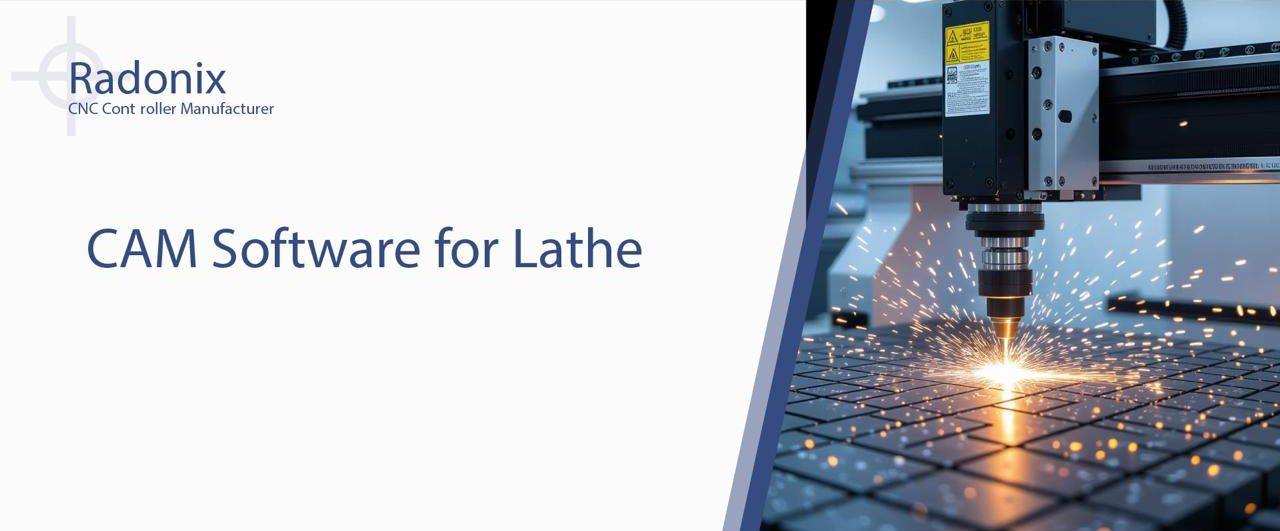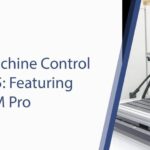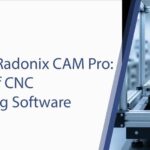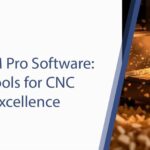At Radonix, we specialize in integrated CAD/CAM solutions like our flagship Cam-Pro software, paired with advanced controllers such as the PC-Smart and PC-Pro LAN series.
In September 2025, as we launch our sixth-generation open-source, cloud-based controllers, CAM integration for lathes is evolving rapidly, incorporating AI-driven optimizations and real-time data syncing.
Whether you’re turning intricate wooden spindles or high-tolerance metal shafts, Radonix Cam-Pro empowers users to generate efficient G-code, reduce setup times, and achieve sub-micron accuracy—making it an ideal choice for SMEs and enterprises alike.
If you’re exploring CAM software for lathe machines, this comprehensive guide is tailored to your needs. We’ll delve into the essentials, top features, implementation strategies, and how Radonix stands out amid 2025’s trends like AI toolpath optimization and cloud collaboration.
By leveraging Radonix Cam-Pro, you can boost productivity by up to 45%, minimize material waste, and stay ahead in a market where intelligent manufacturing is king. Let’s explore how this software revolutionizes lathe operations for superior results.
What is CAM Software for Lathe? The Core of Precision Turning
CAM software for lathe is a specialized tool that converts digital designs into machine instructions, generating G-code for CNC lathes to perform turning, facing, threading, and grooving operations.
Unlike general milling CAM, lathe-focused software emphasizes radial movements along the X and Z axes, with support for live tooling in advanced setups.
It accounts for factors like tool turret indexing, chuck clamping, and material properties to ensure smooth, chatter-free cuts.
In 2025, top CAM solutions integrate AI for predictive pathing and cloud-based simulations, as highlighted in recent industry reports on machining trends. Radonix Cam-Pro excels here, offering seamless CAD import (DXF, STL, STEP) and lathe-specific modules.
Designed for our XZA Wood Turning interface—ideal for wood lathes—and adaptable to metal turning via PC-Smart controllers, it supports up to 4 axes for complex profiles like balusters or shafts. Key features include:
- Tool Path Generation: Roughing, finishing, and threading cycles with automatic compensation for tool nose radius.
- Simulation Tools: 3D previews to detect collisions, reducing scrap by 30%.
- Post-Processors: Customizable for Radonix hardware, ensuring compatibility with high-pulse outputs (up to 500,000 pulses/second).
Compared to standalone software, Radonix’s integrated approach links CAM directly to controllers, enabling real-time feedback loops for adaptive machining.
Benefits of Using CAM Software for Lathe Operations
Adopting CAM software for CNC lathe yields significant advantages, particularly in efficiency and quality control. With global CNC markets emphasizing automation, these tools are indispensable.
Improved Accuracy and Repeatability
Manual programming risks errors; CAM automates it. Radonix Cam-Pro uses parametric modeling to maintain tolerances under 0.01mm, crucial for aerospace or automotive parts. In wood turning, it adjusts for grain variations, preventing tear-out.
Time and Cost Efficiency
Automated nesting and optimization cut programming time by 50%. Our software’s AI enhancements (previewed in seventh-gen controllers for 2026) suggest optimal feeds/speeds, saving 20-25% on cycle times. SMEs report ROI within months through reduced labor.
Versatility Across Materials and Projects
From softwoods to alloys, Cam-Pro handles diverse setups. Support for live tooling enables milling on lathes, expanding capabilities for hybrid operations like keyway slotting.
Enhanced Safety and Workflow Integration
Built-in checks for over-travel and tool breakage alerts enhance safety. Cloud integration in our sixth-gen controllers (launched Q1 2025) allows remote monitoring, aligning with Industry 5.0 trends.
Sustainability Gains
Optimized paths minimize energy use and waste, supporting 2025’s eco-focus in manufacturing.
Table of Benefits:
| Benefit | Description | Radonix Cam-Pro Impact | Industry Benchmark |
| Accuracy | Tight tolerances via simulation | Sub-0.01mm control | 40% error reduction |
| Efficiency | AI-optimized paths | 50% faster programming | Cycle time savings |
| Versatility | Multi-material support | Wood/metal turning | Hybrid ops enabled |
| Safety | Collision detection | Real-time alerts | Downtime cut by 35% |
| Sustainability | Waste minimization | Eco-path algorithms | 25% less material use |
These align with 2025 trends like AI integration and digital twins for virtual testing.
Top CAM Software for Lathe in 2025: Where Radonix Fits In
The CAM landscape in 2025 features robust options, but Radonix Cam-Pro offers unique value for lathe users.
- Mastercam: Leader in multi-axis turning; excels in complex geometries but pricey for SMEs.
- Autodesk Fusion 360: Cloud-based, affordable; great for beginners with lathe modules, though less specialized.
- Siemens NX CAM: Enterprise-grade for high-end turning; integrates digital twins but steep learning curve.
- ESPRIT: Strong in Swiss-style lathes; AI features emerging in 2025.
- SOLIDWORKS CAM: Integrated with CAD; basic turning but expandable.
- hyperMILL: Advanced for 5-axis; overkill for simple lathes.
Radonix Cam-Pro stands out with its hardware-software synergy, free updates, and affordability (under $500 bundles). Tailored for our XZA interface, it supports wood turning specifics like variable speeds for irregular shapes. In comparisons, users praise its ease over Fusion for Radonix ecosystems, with 2025’s open-source elements fostering community customizations.
Step-by-Step Guide to Using Radonix Cam-Pro for Lathe Programming
Implementing CAM software for lathe is simple with Radonix. Here’s a tutorial for turning a wooden spindle.
Step 1: Design Import and Setup
Launch Cam-Pro (Windows-compatible). Import CAD model; define stock (e.g., 300mm oak cylinder). Set lathe parameters: Chuck type, tailstock support.
Step 2: Tool Library Configuration
Select tools: Roughing gouge (RPM 1500), parting tool. Input nose radius, insert geometry. Cam-Pro auto-suggests based on material.
Step 3: Path Generation
Create operations: Rough turning (depth 2mm/pass, feed 100 mm/min), finishing (0.5mm/pass). Add threading if needed. Simulate in 3D to verify.
Step 4: Optimization and Post-Processing
Use AI tools (beta in sixth-gen) for path smoothing. Export G-code with Radonix post-processor for PC-Smart upload.
Step 5: Machine Execution and Monitoring
Connect via Ethernet; home axes. Run program; monitor via dashboards. Adjust overrides for real-time tweaks.
Step 6: Analysis and Iteration
Review logs; export metrics. Cloud features enable sharing for team reviews.
Pro Tips for 2025:
- Integrate IoT sensors for tool wear prediction.
- Use subscription models for updates.
- Avoid pitfalls like ignoring backlash—calibrate quarterly.
This process halves traditional times, per user feedback.
Advanced Features in Radonix Cam-Pro for Lathe Applications
For pros, Cam-Pro offers:
- Live Tooling Support: Mill flats or drill on rotating parts.
- Multi-Axis Turning: Up to 4 axes for contoured profiles.
- Custom Macros: For repetitive cycles like knurling.
- Integration with ERP: Sync production data.
In wood lathes, XZA interface optimizes for vibration control. Upcoming AI (2026) will predict chatter, enhancing finishes.
Case Study: An Iranian woodworking firm using Cam-Pro for baluster production reduced defects by 32%, scaling output 2x.
2025 Trends in CAM Software for Lathe Machines
Per recent analyses, trends include:
- AI Optimization: Auto-adjusting paths for efficiency.
- Cloud Collaboration: Remote programming, as in our sixth-gen.
- Digital Twins: Virtual replicas for testing.
- Subscription Models: Flexible access.
- Sustainability Focus: Eco-friendly algorithms.
Radonix leads with open-source and AI plans, ensuring compatibility with robotics in CNC shops.
Conclusion: Elevate Your Lathe Operations with Radonix Cam-Pro
CAM software for lathe is essential for precision turning, and Radonix Cam-Pro delivers it with innovation and affordability. From basic profiling to advanced hybrids, our ecosystem—backed by evolving controllers—empowers your success.
Contact Us:
- E-Mail: info@radonix.com
- Phone: +90 (553) 920 5500








